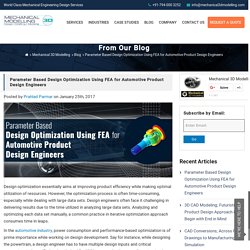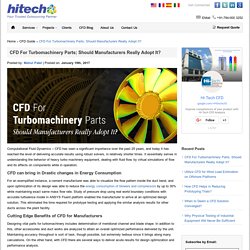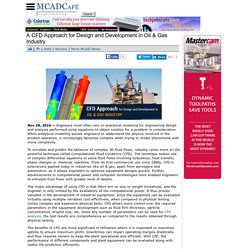

CFD for Flow Modelling In Oil & Gas Applications to Derive Reliable Predictions & Solutions. »News»Industrial Equipment» CFD for Flow Modelling In Oil & Gas Applications to Derive Reliable Predictions & Solutions Industrial Equipment Posted by Kashyap Vyas on January 24th, 2017 For more than a decade engineers used equations to evaluate engineering solutions to given problems, the one we fondly know as “analytical modeling”.

However; the challenge was that underlying equations became more complex on attempting to model phenomena with multiple complexities, making it a barrier to solve equations with help of analytical mathematics. Parameter Based Design Optimization Using FEA For Automotive Product Design Engineers. Posted by Prahlad Parmar on January 25th, 2017 Design optimization essentially aims at improving product efficiency while making optimal utilization of resources.

However, the optimization process is often time-consuming, especially while dealing with large data sets. CFD For Turbomachinery Parts; Should Manufacturers Really Adopt It? Computational Fluid Dynamics – CFD has seen a significant importance over the past 25 years, and today it has reached the level of delivering accurate results using robust solvers, in relatively shorter times.

It essentially serves in understanding the behavior of heavy turbo machinery equipment, dealing with fluid flow, by virtual simulations of flow and its effects on components while in operation. CFD can bring in Drastic changes in Energy Consumption. Essentials of Product Manufacturing: CAD models and FEA. Gone are the days when research and development engineers, design engineers and manufacturers used to fabricate a component and test it against physical testing methods with destructive testing approaches.

Mostly all the components undergo structural model based analysis approach using software like ANSYS or calculative analysis approach to check the design strength and safety. Ideally, any component that is designed passes through several processes of calculation, checks, compatibility, tests, and analysis for various purposes before being fabricated. However, there are two major processes involved that has a huge impact on the overall product development. Generating 3D CAD Models. Structural Analysis of Bridges Using FEA, a Sophisticated Approach. A trend of constructing sky scrapers and grandiose bridges has become a measure to determine how technologically advanced the construction firm is.

These firms constantly engage in erecting immense structures and bridges across large water mass, as a consequence to increase in population density and frequent long distance commutation. Since structures are constantly subjected to varying loads, the possibility of earthquakes, high winds, water currents and other loading, they must be designed with massive strength and load carrying capacity. This is possible today, through amalgamation of advanced technology and engineering principles, and is already revolutionizing the way construction projects are planned and executed. Among the modern construction works, bridges have captured the attention of researchers and design engineers.
A CFD Approach for Design and Development in Oil & Gas Industry. Nov 28, 2016 -- Engineers most often rely on analytical modeling for engineering design and analysis performed using equations to obtain solution for a problem in consideration.

While analytical modeling assists engineers to understand the physics involved in the product operation, it increasingly becomes complex when trying to model phenomena with more complexity. To simulate and predict the behavior of complex 3D fluid flows, industry relies more on the powerful technique called Computational Fluid Dynamics (CFD). The technique makes use of complex differential equations to solve fluid flows involving turbulence, heat transfer, phase changes or chemical reactions. From its first commercial use since 1980s, CFD is extensively applied today in industries like oil & gas, apart from aerospace and automotive, as it allows engineers to optimize equipment designs quickly. Simulation Tools to Develop Energy Efficient Products.
The market today, is demanding more sustainable and energy efficient products.

As such, companies have started realizing that the idea of developing sustainable and green products is no longer a regulatory requirement, but a new growth area to remain profitable. Research from CIM data and the International Energy Agency suggests that two-third of the global targeted green-house gas emission reductions can be achieved by making improvement in energy efficiency and investing in renewable energy. Thus, both these approaches open new product development opportunities for businesses. However, this can only be achieved if engineers leverage the product designing process through the use of simulation tools. 4 Reasons to Use Design Simulations to Improve Equipment Fabrication. Design simulations are increasingly becoming important in real-world applications.

Be it about obtaining a driver’s license or learning to fly an aircraft, simulators are used in diverse business settings for different purposes. Through simulation, outcomes can be predicted mathematically, so that risks can be assessed, products can be improved and failures can be avoided before even performing physical tests. To improve the equipment fabrication, design simulations are extremely useful in improving the outcomes.
Utilize CFD for Wind Load Estimation on Offshore Platforms. Offshore platforms are designed considering the effects of wind loads on the structure, to ensure its safety and reliability.

It is important to perform wind load estimation early during the design phase to avoid changes in the design later during the development stage. Conventionally, wind load estimations are performed in a wind tunnel, but these tests can only be performed once the platform design has reached to a level that can be defined. Thus, there is only limited information available with the design engineer during initial stages.
Late changes in the configuration further introduce uncertainty as any change will affect the stability of the platform against wind loads. Use Shell Elements for Finite Element Analysis of Thin-Walled Parts. Improve the Design of Industrial Valves Cost-Effectively Using CFD. Using CFD beyond Aerospace and Automotive Applications. CFD (Computational Fluid Dynamics) has come a long way from being a specialized tool used for expensive aerospace designs to a more generalized tool easily available for engineers to test any product undergoing fluid flow interaction.

This is largely due to the democratization of CFD software, enabling engineers to optimize product designs quickly and efficiently. Companies apart from automotive and aerospace segment are enjoying the benefits of this tool successfully, without needing special expertise and thus add value to their end customer. Further, companies like ANSYS are enabling the CFD tool to reach new markets and customers by making it cost-effective through flexible licensing and on-demand options. How Manufacturers Can Develop Efficient Pump Designs Using CFD. The fiercely competitive market, where customer demands shift consistently and environmental challenges keep on growing, product manufacturing businesses are facing extreme pressure on improving product efficiency and usefulness.
The fiercely competitive market, where customer demands shift consistently and environmental challenges keep on growing, product manufacturing businesses are facing extreme pressure on improving product efficiency and usefulness. Best-in-class companies consider revamping their existing product lines or develop completely new products from scratch to meet these challenges, and this is very much evident in case of pump and fan manufacturing industry. As an example, new pump efficiency standards from the U.S. Department of Energy require today's least-efficient 25% of the pumps to be redesigned to conserve energy.
Moreover, by 2023, the new rooftop air conditioning standards require increasing the efficiency of pumps by at least 25% to save electricity. Predict Complex Behavior of Your Products with Simulation. Simulating Dynamic Response of a Structure with Fasteners in FEA. It is often difficult to simulate the dynamic response of structure consisting of number of screws or bolts, since it is expensive to represent every single hardware items in the simulation. It not only consumes time in setting up the simulation, but also eats up the computational time significantly. How CFD Helps in Reducing Prototyping Trials? It is increasingly becoming challenging for manufacturers to maintain competitive edge, especially with the fast changing technology, growing regulatory compliances and customer demands for improved performance.
Differentiating from other competitors and yet remaining profitable is what manufacturers look to achieve today. However, in this pursuit, there is one often neglected area in design development that can be utilized as a competitive tool to achieve the goals faster – Computational Fluid Dynamics (CFD). Develop Reliable Heavy Industrial Equipment with Simulation.
How Finite Element Analysis is Helping Design the Future. People often wonder how engineering marvels like the Boeing’s 787 Dreamliner, consisting of a massive 50,000 horsepower engine, made up of 18,000 complex parts is brought to life. While it takes a plethora of tools and technologies to bring such state-of-the-art, super-efficient aircraft in the market, there is one significant tool that outshines the rest – Finite Element Analysis (FEA). With its capabilities to optimize designs before even the first prototype is built, FEA or the Finite Element Method (FEM) has played a critical role for Rolls Royce to develop such a massive and highly efficient engine for the Dreamliner project. Rolls-Royce utilized FEA to conduct different studies to understand critical design aspects of engine components like stress, structural strength, fatigue life, dynamics, thermo-mechanical effects, aeromechanics and much more.
Improved Finite Element Simulations to Expedite Product Development. Sheet metal parts are increasingly being developed by simulating the deformation process, in order to optimize the development time and improve the design quality. These simulations are often compared with modern optical measuring methods working on the principle of image processing to provide detailed information on 3D surface geometry, deformation as well as strain on formed sheet metal components.
Together, the FEA and optical measuring systems play a significant role in the industrial product development cycles. Product Designing with Finite Element Analysis Boosts Development Process. Finite Element Analysis (FEA) is an integral part of product development processes today. It has enabled engineers and designers to quickly evaluate the product design, determine stresses, deformation, useful life and failure characteristics within few numerical iterations. The problem however is that the process of performing simulation and the people who perform it are often different from the original design team. Geomagic Plug-in For SolidWorks, Expedites Reverse Engineering For Legacy Products. 0inShare. Maintaining Classic Vehicles with Modern Design & Manufacturing Tools. Posted by Kashyap Vyas on August 31st, 2016 Classic or heritage cars are always fascinating; the history it has seen & the places it has been and the people it has seen, moves most of us and imbibe a desire to have at least one of this vintage human invention in our garage.
Why 3D CAD Models of a Building are translated to 2D drawings? Why 3D CAD Models of a Building are translated to 2D drawings, to be built in Three Dimensions? Aug 15, 2016 -- Though the approach to building design has evolved tremendously, it still starts with a rough paper sketch. 3D Modeling. Retail Store Furniture Design for Manufacturability (DFM) Support, Hiral Patel. The Objective Improving the engineering, prototyping and manufacturing lead time for furniture designed for retail stores and expedite the delivery to customers. The Solution The design of one of the retail store furniture was converted from 2D to 3D for greater visibility, considering the client’s Design for Manufacturing (DFM) strategy, manufacturing processes and product requirements.
Why Is Outsourcing Engineering Services An Emerging Need Of Manufacturers? In the last decade or so we have beheld incredible progress in the engineering services outsourcing market. The Insider's Guide to Mechanical Engineering. Posted by Hi-Tech CADD Services on Thursday, June 5, 2014. How Reverse Engineering is Useful for Improving Design and Manufacturing? Understanding Vehicle Crashworthiness and Significance of FEA in Automobile Safety. Using Reverse Engineering Techniques for Product Innovation: The Legitimate Way. Improving the Performance of Venturi Scrubbers Using Computational Fluid Dynamics.
4 Ways to Accelerate 3D Modeling Process and Bring Products Faster to the Market. CFD Analysis for Engine Design: Fuelling Innovation. 4 Reasons Why You Should Use CFD to Design Industrial Heat Exchangers. Structural and Vibration Analysis of Bracket Design. CFD Analysis for Performance Optimization of Radiator Fan. Predicting Fatigue in Pressure Vessels Using Finite Element Analysis. Improving Frictional Grip between Pipe and Bracket for Engine Oil Line. Eliminating Hot Spots Using Computer Aided Engineering. Development of an Optimized Oil Storage Tank Design. Separation Efficiency Estimation of Oil and Gas Separator. CFD: An Intuitive Tool for Efficient Thermal Management of Data Centers.
Design Optimization of Cooling Component through CFD Analysis. Visualizing Fluid Flow Inside the Modified Inlet Duct. Evaluate the HVAC Capability of the Proposed Airport Design. Rethinking Product Development: Why You Should Adopt Simulation. CAE Driven Product Development: A Competitive Tool for SMEs. Computational Aero-Acoustics to Reduce Vehicle Noise. CFD Helps to Predict the Flow Behaviour inside Building HVAC Application. Structural Assessment of Tower Subjected to Wind and Wave Loads. Checklist to Ensure Validity of Your Finite Element Structural Analysis.